Exploring Folding Paddle Boards and Kayaks: A Guide
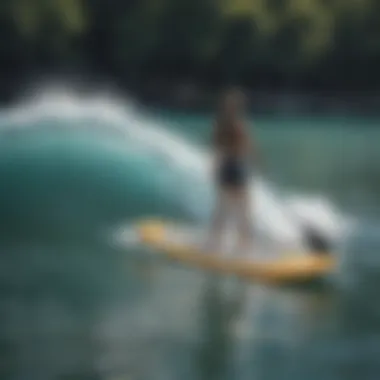
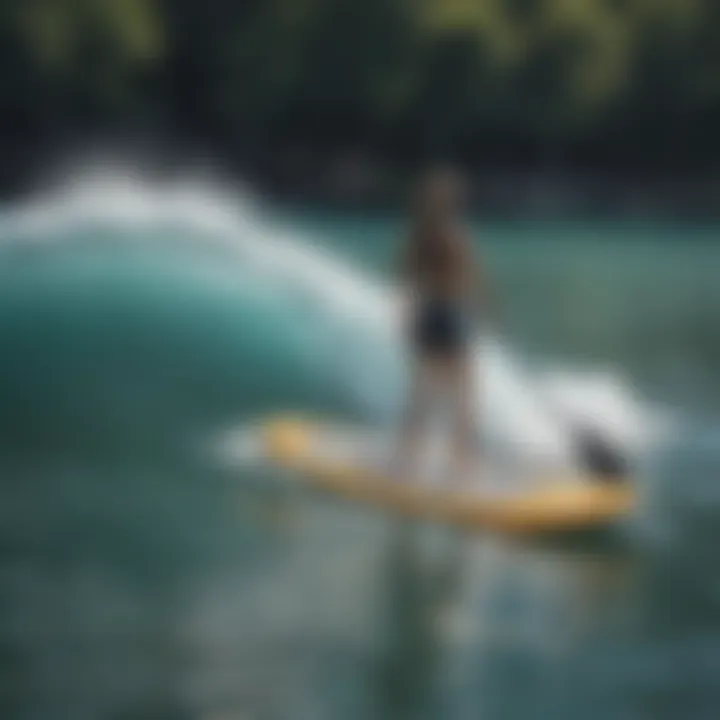
Intro
The ocean has always beckoned adventurous souls, opening itself as a vast playground for surfers. With the recent surge in popularity of folding paddle boards and kayaks, it’s essential to explore how these innovations meet the needs of today’s surfers. This article dives headlong into their intricacies, examining the designs, functionality, and their growing relevance in the surfing community.
Folding paddle boards and kayaks represent a fusion of convenience and performance that traditional models might struggle to match. Portability is a significant draw for many. These watercraft can be easily stored and transported, breaking free from the limitations of rigid structures. Considering the varying experience levels of surfers—from those who can barely stay upright on a board to seasoned veterans who ride the big waves—there’s a compelling impetus to delve into how these formats compare to their traditional counterparts.
We'll also take a close look at user experiences and preferences, giving you insights that transcend mere specifications. By the end, whether you’re seeking to enhance your adventures or are contemplating making the leap into the world of folding boards and kayaks, this guide aims to offer valuable perspectives and practical guidance.
Surfboarding Techniques
Surfing is more than just riding waves; it’s a blend of skill, balance, and technique. Understanding the nuances can make or break your experience out on the water, especially when you’re using a folding paddle board or kayak.
Beginner Tips for Mastering the Basics
- Posture is Key: Keep a low center of gravity. Bend your knees while keeping your back straight. This stance will give you better balance.
- Paddle Correspondingly: When on a kayak, alternate your strokes on either side to maintain a straight course. This is a beginner's mistake that can lead to zig-zagging all over the place.
- Pick Your Waves Wisely: For those venturing onto a paddle board, start with smaller, less intimidating waves. Focus on getting used to how your craft responds to the surf.
Advanced Techniques for Seasoned Surfers
- Weight Distribution: Understanding how to shift your weight can help you better maneuver both paddle boards and kayaks. Lean forward for speed and stability when cutting through the water.
- Using the Wave: Engage with the energy of the wave by angling your board in a position that maximizes speed without sacrificing control. This is a dance with nature itself.
- Recovery Techniques: While navigating choppy waters, knowing how to recover from a wipeout—using the board’s buoyancy to regain your footing—can save your surfing session.
"Experience is the best teacher. Each wave offers a lesson, and those willing to learn can ride the tides of advancement."
Surfboard Equipment
In the realm of surfing, equipment can dramatically influence one’s performance and enjoyment. When it comes to folding paddle boards and kayaks, the technology and materials significantly differ from traditional gear.
Reviews of the Latest Surfboards on the Market
The current landscape is dotted with several brands that claim superior quality and performance. Some noteworthy models include:
- Red Paddle Co: Known for their inflatable paddle boards, combining durability with lightweight design, ideal for on-the-go surfers.
- Oru Kayak: These folding kayaks stand out for their innovative design that allows for easy transport without compromising on performance.
- BOTE: Their range of paddle boards and kayaks caters directly to the needs of versatile adventurers.
Essential Gear for Every Surfboarder
- Rash Guards: Protect your skin from sunburn and chafing.
- Leash: A crucial aspect of safety, ensuring your board doesn’t drift away after a fall.
- Personal Flotation Device (PFD): Particularly necessary for kayakers, maintaining safety on the water should always be a priority.
Choosing the right gear not only enhances performance but also supports your journey toward surf mastery. Whether you’re just starting or looking to upgrade your setup, being aware of the tools available can make a noticeable difference.
Understanding Folding Paddle Boards
Folding paddle boards have carved a niche in the surfing community, truly exemplifying convenience and innovation. Understanding these watercraft means appreciating their unique design, functional benefits, and how they meet the needs of today's adventurous surfers. For those who roam the open waters or chase the perfect wave, folding paddle boards offer a blend of portability and performance that is hard to overlook. As we dive into their complexities, it becomes clear that they can be a game changer for both casual paddlers and experienced surfers.
Definition and Purpose
At its core, a folding paddle board is designed to provide an alternative for surfers who value ease of transport without compromising stability and performance. These boards are constructed in such a way that they can be collapsed into a more compact form, making it straightforward to fit them into a car trunk or to carry them across long distances.
Unlike traditional paddle boards, which can be cumbersome and unwieldy, folding boards offer the flexibility needed for those spontaneous adventures. Whether you’re heading to a distant beach or looking for a quick evening session at a local lake, these ultra-portable models allow users to maximize their surfing experience without the stress of lugging heavy equipment.
Evolution of Design
The design of folding paddle boards has come a long way since their inception. Initially, the concept was centered around basic functionality—just a way to get from point A to B with minimal fuss. However, as the sport gained popularity, the focus shifted to quality. Today’s models boast advanced engineering techniques and materials that enhance durability and performance.
- Air Chambers: Many modern folding paddle boards use air chambers to keep weight to a minimum while maximizing buoyancy.
- Compact Folding Mechanisms: Advanced folding systems allow for quick assembly and disassembly, so users can easily set up on the go.
- Improved Stability Features: Engineers have fine-tuned the board shape, ensuring that even with a foldable design, stability isn’t sacrificed in choppy waters.
Through continual innovation, the evolution of folding paddle boards reflects the ever-changing demands of surfing enthusiasts aiming for performance, all while maintaining convenience.
Core Materials Used
When we talk about folding paddle boards, the materials play a crucial role in determining the board's overall performance and longevity. The most common materials used in making these boards include:
- Drop-Stitch Polyester: This popular material features thousands of interconnecting threads that create a rigid structure when inflated. It’s lightweight yet strong, making it ideal for portability.
- PVC Tarpaulin: Often utilized in the outer layer, this material provides excellent durability. It is resistant to punctures and abrasions, ensuring that your board stands the test of time, even in rough conditions.
- Reinforced Seams: The seams are often reinforced using high-quality adhesive techniques, which add strength and preserve the integrity of the board through countless outings.
All these materials work together, allowing the folding board to maintain its shape, improve buoyancy, and provide a smooth paddling experience, all while being easily collapsible for transport.
"When you want to hit the water spontaneouly, folding paddle boards make it a breeze!"
Kayaks in the Surfing World
Kayaks have carved a significant niche within the surfing community, reflecting a harmony between function and thrill on the water. They are not just vessels for navigation; they transform mundane outings into exhilarating experiences. Surfers can mix the art of paddleboarding with kayaking to engage dynamically with waves, whether riding the swell or gliding smoothly over still waters. This blend of features speaks directly to adventurers seeking versatility.
Historical Development
The journey of the kayak stretches across centuries, originating from indigenous tribes. The Eskimos crafted kayaks from sealskin stretched over a wooden frame, relying on their design for sustenance hunting in icy waters. These initial crafts were more than mere transportation; they represented engineers' wisdom tailored to unique needs and environments. As time marched on, kayaks evolved, adopting materials like fiberglass and plastics, thus enhancing durability and agility. It's fascinating how today's kayaks, often vibrant in color, reflect not just utility but the aesthetic sensibilities of modern maritime culture.
The shift towards recreational use began in the mid-twentieth century, giving rise to various designs such as sit-on-top, touring, and whitewater kayaks. This transformation opened doors for sports enthusiasts, allowing them to engage with nature in thrilling ways. Kayaking soon found its place alongside surfing, as paddlers sought waves, skillfully riding on crests while harnessing the currents of rivers, lakes, and oceans alike.
Types of Kayaks
When it comes to choosing a kayak, the options are as diverse as the waters they navigate. Each type boasts distinct features tailored for different experiences, making it crucial for surfers to align their choice with their intended adventure. Here are some of the most common types:
- Sit-on-top Kayaks: Perfect for warm climates, these kayaks have an open top, making them easy to get in and out of. They're ideal for leisurely paddling and fishing, offering ample stability for beginners.
- Touring Kayaks: Designed for longer expeditions, these slender crafts track well over distances, making them suited for those who want to explore coastlines or rivers without much interruption.
- Whitewater Kayaks: Compact and robust, these are built to withstand rough waters. Surfers who thrive on adrenaline will appreciate how these kayaks navigate through rapids and sharp turns.
- Folding Kayaks: A nod towards portability, these models can be disassembled and stored, marrying convenience with performance. They are ideal for campers and adventurers who want to travel light yet enjoy the thrill of kayaking.
- ** Inflatable Kayaks**: Lightweight and often more affordable, these options are gaining traction for casual outings. They can be inflated quickly, offering flexibility to those who may not have the space to store traditional kayaks.
Each type delivers a distinctive experience on the water, and understanding these nuances can elevate a surfer's adventure. Whether one seeks thrill or tranquility, kayaks can adapt, proving their indispensable role in expanding the horizons of surfing culture.
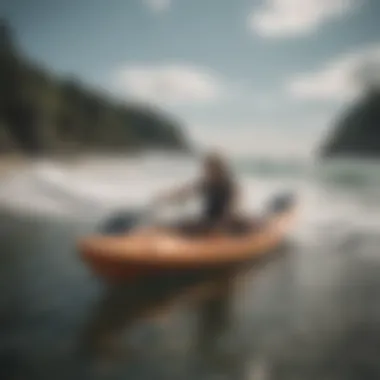
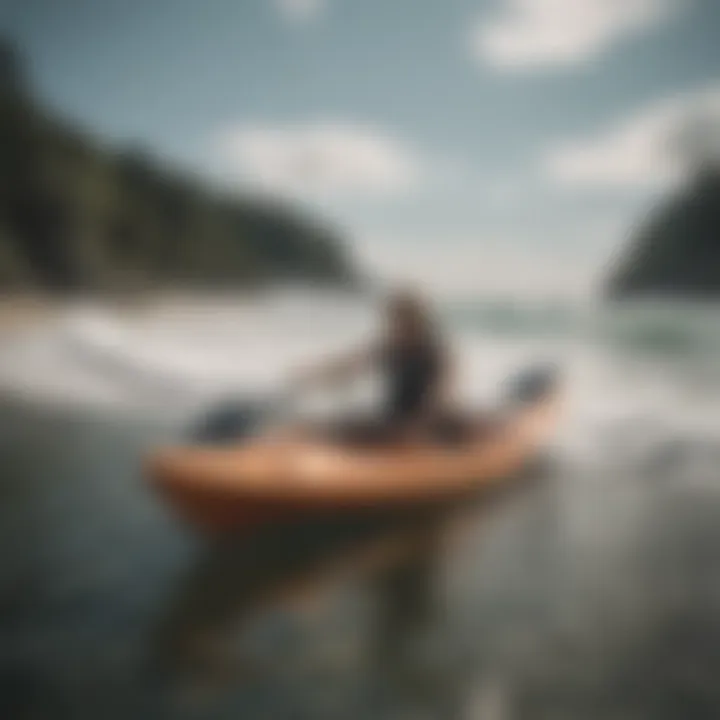
Comparative Analysis: Folding Paddle Boards versus Traditional Paddle Boards
When it comes to water sports, particularly surfing and paddling, the choice between folding paddle boards and traditional paddle boards isn't just about aesthetics or brand loyalty. It dives deeper into practical considerations that impact portability, performance, and overall user experience. By looking closely at these two categories, we can draw meaningful insights that will not only inform potential buyers but also shape how enthusiasts approach their adventures on water.
Portability Considerations
One of the standout features of folding paddle boards is, quite frankly, their portability. Unlike traditional boards that can be a hassle to transport, folding paddle boards conveniently collapse into compact sizes, making them easy to store in a car trunk or even in small apartments. This is particularly advantageous for those who may not have the luxury of a spacious garage or vehicle. You can often carry a folding paddle board like a backpack, slinging it over your shoulder as you make your way to the beach.
However, it’s necessary to recognize that while portability is a feather in the cap for folding models, traditional paddle boards still hold their ground when it comes to stability. Weighing more and being sturdier, traditional boards remain a popular choice for surfers who prioritize control in waves. Thus, if you plan on tackling rough waters regularly, it might be worth considering the balance between portability and performance.
"Where there’s water, there’s adventure. But how you get there makes all the difference."
Performance Metrics
Performance metrics draw a clearer line in the sand between folding and traditional paddle boards. Folding paddle boards often excel in calm conditions; however, issues may arise in choppy waters. Their flexibility can make for a wobbly ride, especially for those who are still getting their sea legs. Newer materials and innovative designs are helping to improve this, but it’s still a point to mull over for serious surfers.
On the flip side, traditional paddle boards generally offer superior tracking and stability due to their rigid construction. This provides users with a more confident stance when surfing waves. This kind of board can smoothly glide over water, making it an appealing option for those who prioritize speed and performance during their sessions.
To succinctly capture the differences, here’s a quick comparison:
- Folding Paddle Boards
- Traditional Paddle Boards
- Pros: Highly portable, easier to store, versatile for different environments
- Cons: Less stability in rough waters, potential for wobbling
- Pros: Greater stability, better control in waves, designed for performance
- Cons: Bulky, more challenging to transport and store
Advantages of Folding Paddle Boards
In the realm of aquatic adventures, folding paddle boards have managed to carve out a niche that’s hard to ignore. Not only do they cater to the increased demand for portability, but they also accommodate a myriad of lifestyles and preferences. For today’s surfing enthusiasts, understanding the benefits of these innovative watercraft can significantly influence their choice in equipment.
Space Efficiency
When it comes to space, folding paddle boards are like a godsend for urban dwellers and those living in tight quarters. These boards, which can easily collapse and fit into relatively small spaces, are perfect for those who often juggle multiple hobbies or lack storage options. Whether you're residing in a studio apartment or need a compact setup for traveling, these boards give you the luxury of time and space.
Consider this: traditional boards require ample storage space and are quite cumbersome. In contrast, the compact nature of folding boards means you can stash one away in a closet, in the trunk of your car, or even under a bed without a hitch. This space-saving characteristic does not merely appeal to practicality; it enhances your ability to transition from thought to action. You are more likely to take that spontaneous trip to the water when your board isn’t taking up half your garage!
Moreover, this advantage often leads to less impact on your environment. By utilizing compact equipment, you naturally reduce clutter. Less clutter often translates into a more organized and stress-free living space, allowing surfers to focus on their next wave rather than worrying about how to fit their gear.
Enhanced Storage Features
Folding paddle boards often come with enhanced storage features that make them stand out in comparison to traditional paddle boards. Thanks to innovative designs and technology, these boards often boast additional compartments or built-in straps tailored to securely hold personal items, snacks, or even your favorite water bottle while you embark on your aquatic journeys.
You might find additional attachment points for accessories such as fishing gear, waterproof pouches, or even coolers designed specifically for these boards. This storage capability allows you to enjoy longer outings without the need for extra bags or cumbersome equipment. Going back and forth to the shore is less of a chore when your essentials are right at hand, neatly tucked away yet easily accessible.
"A paddle board that folds is not just about convenience; it redefines how we explore the waterways, making adventures more accessible and enjoyable."
In addition, many folding paddle boards are designed with lightweight materials, so carrying them with all this integrated storage becomes less of a physical burden. This design consideration is crucial for surfers who may want to navigate varied terrains from sandy beaches to rocky shores, as it ensures that the board remains manageable without sacrificing performance.
Disadvantages of Folding Paddle Boards
While folding paddle boards might seem like a dream come true for surf enthusiasts—combining convenience with performance—it's critical to address the not-so-glamorous side of these innovative craft. Understanding the drawbacks can save potential buyers from disappointment and support more informed decisions about whether these boards are right for their adventures.
Potential Durability Issues
Durability could be the Achilles' heel of folding paddle boards. Unlike traditional solid boards made of durable materials like fiberglass or epoxy, folding boards are often constructed from flexible materials which might not withstand the rigors of the ocean as well.
These boards often feature hinges or seams that are designed to allow folding; however, this aspect can be a double-edged sword. Over time, these connection points could weaken. Surfers may find that constant exposure to UV rays, saltwater, and the general wear and tear of transport can affect these areas significantly.
- Swelling and Moisture Issues: Some folding models can also absorb water over time, leading to swelling. It’s advisable to always dry the board thoroughly before storing.
- Repair Difficulties: When a folding board gets dinged, repairing can be a bit tricky. Traditional boards tend to have more straightforward and accessible repair methods, whereas folding boards may require specialized skills or parts.
This doesn't mean all folding paddle boards are doomed to a short life; it's about knowing what to look for and how to care for them properly. Consumers should pay close attention to the materials used and consider warranties offered by different manufacturers to gauge their confidence in durability.
Cost Considerations
Cost can also be a sticking point for many surfers considering folding paddle boards. They often come at a premium price compared to their traditional counterparts. This can be a letdown, especially when buyers realize the boards may not always deliver on performance or longevity.
- Higher Initial Investment: Folding models draw a higher initial investment due to intricate designs and advanced materials. Surfers who are on a budget may find it hard to justify this cost, especially when compared to more affordable, traditional boards.
- Potential for Higher Replacement Costs: If the durability issue rears its ugly head, surfers may find themselves replacing their board sooner than expected. The added costs of repairs or even outright replacements can add a strain on an adventurer’s wallet.
As a point of reference, prices for folding paddle boards can vary widely, but enthusiasts might find themselves spending anywhere from a few hundred to over a thousand dollars, depending on the brand and features—money that could potentially buy a more durable traditional board.
"An informed buyer is an empowered buyer." Making a choice without understanding these potential downsides could lead to regrets down the line.
In summary, while folding paddle boards provide excellent features like portability and ease of storage, it's essential to weigh these benefits against the durability concerns and higher costs that come along with them. More than ever, careful research will help buyers ensure they're making an investment that fits their watercraft needs.
The Versatility of Kayaks
Kayaks are a staple in the world of water sports, and understanding their versatility is crucial for any surfing enthusiast. These slender, often colorful crafts offer a broad spectrum of uses that go beyond just surfing. The ability to easily navigate rivers, lakes, and coastal waters make them a vital addition to any water lover's arsenal.
On-water Performance
The on-water performance of kayaks can vary greatly based on design and intended use. Different shapes and sizes cater to various activities. For instance:
- Recreational Kayaks: These are typically wider and offer greater stability, making them fantastic for casual paddling. They provide ease of use for beginners eager to explore still waters.
- Sea Kayaks: Built for longer journeys, they are more streamlined and can handle ocean waves well. Their performance shines in open water, allowing seasoned paddlers to travel significant distances with relative ease.
- Whitewater Kayaks: If the adventure calls for rapids, whitewater kayaks are designed to withstand turbulent conditions, providing a thrilling ride while allowing the paddler to maneuver through challenging waters.
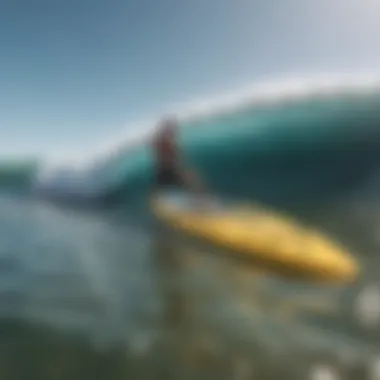
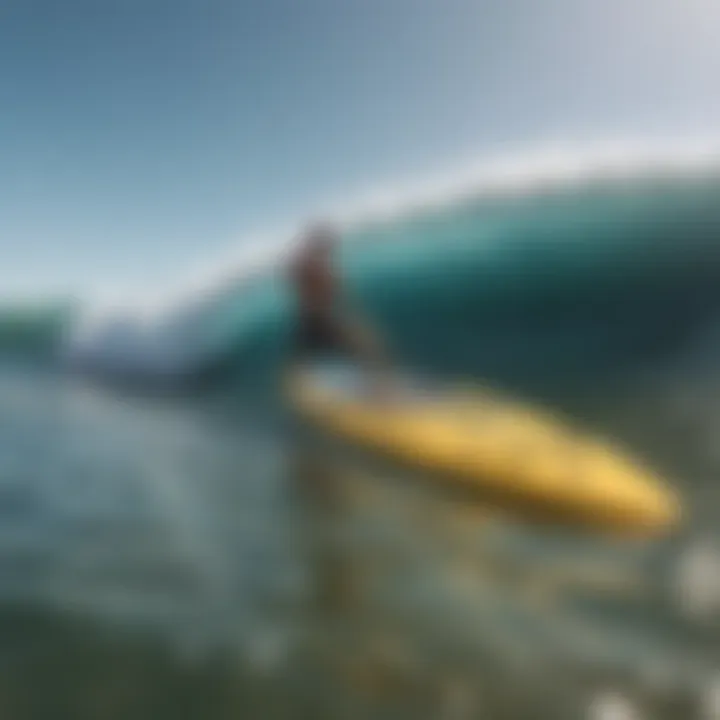
To enhance performance, many kayaks now incorporate technologies such as adjustable skegs and rudders. These features allow paddlers to maintain directional stability even in choppy waters. Some examples includes the Old Town loons, which merges lightweight construction with durability, making it ideal for versatile water conditions.
Adaptability to Various Conditions
One of the most impressive features of kayaks is their adaptability to various water conditions. Kayakers often find themselves in differing environments throughout their journeys—be it a placid lake or the roaring surf. This adaptability is essential for a few reasons:
- Design Variability: Kayaks come in numerous designs tailored for specific conditions. Longer, sleeker models glide effortlessly across calm waters, while shorter, wider ones can keep sturdy during choppy swells.
- Weather Resilience: Many kayaks are available in robust materials that can handle wear and tear from different weather conditions, allowing for paddling rain or shine.
- Gear Compatibility: Numerous kayaks offer adaptability for attaching accessories such as storage compartments, fishing rod holders, and even mounts for action cameras. This means a single kayak can serve multiple purposes—from leisurely paddles to rigorous fishing expeditions.
In essence, kayaks are purpose-built for a myriad of aquatic ventures. Whether one is leisurely paddling at sunset or braving the vibrant waves of the Pacific, the versatility ensures that there's a kayak suited for each occasion. As they say in the world of water sports, "bring your surfboard on a paddle board day, and you might just enjoy the ride even more!"
"Kayaks offer a unique balance of fun and performance, allowing users to adapt their experience based on their environment and needs."
In sum, the versatility of kayaks, paired with the multitude of styles and technologies available, provides an exhilarating opportunity for every paddler. The choice of kayak can indeed define the experience, making it essential for enthusiasts to choose wisely based on their individual ambitions.
Best Practices for Using Folding Paddle Boards
Using folding paddle boards effectively requires a solid understanding of their setup and safety measures. Whether you are a newbie trying to find your kayak legs or a seasoned surfer looking to navigate with a bit more finesse, grasping best practices can make all the difference. These practices help optimize performance and ensure a positive experience on the water.
Preparation and Setup
Before hitting the waves, you'll want to ensure your paddle board is prepped like a pro. Missing key steps in setup can leave you floundering before you even launch. Here are crucial points to keep in mind:
- Inspect the Board: Begin with a thorough inspection. Look out for any tears or damages that could affect how it performs on water. Don’t let your paddle board surprise you with a leak mid-paddle.
- Inflation and Deflation: If your model is inflatable, make sure to follow the manufacturer's recommendations on inflation. Under-inflation leads to instability, while over-inflation can potentially damage the seams. Use a reliable gauge; some folks might eyeball this, but that's a shot in the dark.
- Attach Gear Securely: When heading out, be conscious of what makes the leap from land to water with you. Accessories should be fastened securely to avoid losing anything to the waves. Use bungee cords or straps that are specifically designed for this purpose.
- Check the Weather: Wind and water conditions can change in a flash. Check forecasts and tide charts before you paddle away. An unexpected gust can flip the best of intentions.
- Practice Loading: If your folding paddle board is tackle-style, practice how to break it down and set it back up on land before you venture out. Familiarity breeds confidence, and nothing takes the wind out of your sails like fumbling with unfamiliar gear while it’s go-time.
Safety Tips
Safeguarding yourself while out on the water is paramount. Here are some essential safety tips that can keep you afloat while you enjoy your paddle board adventures:
- Wear a Personal Flotation Device: Many jurisdictions require it, and for good reason. A PFD can provide that extra layer of safety in case you take an unexpected dip.
- Know Your Limits: Don’t paddle beyond your comfort zone. While the ocean can call to you, overexertion can lead to fatigue, leaving you vulnerable. Stick to calmer waters until you’re more experienced.
- Stay Aware of Surroundings: Keep your head on a swivel. Other boaters, swimmers, and natural hazards are real dilemmas in a busy waterway. Practice vigilance as if you were walking through a crowded street.
- Inform Someone: Let a friend, family member, or fellow paddler know your plans. If you happen to run into trouble, they’ll know when and where to look for you.
- Practice Rescues: Familiarize yourself with re-boarding techniques. Trying to get back on your board after a tumble can be more challenging than it appears, particularly for first-timers. Consider practicing this in shallow waters until it becomes second nature.
Ultimately, the essence of using folding paddle boards lies in being prepared and safety-minded. By incorporating these practices, you not only enhance your own experience but also contribute to a safer environment for everyone on the water. Remember, smooth sailing often comes down to the meticulousness of prep work and a dash of common sense.
Evaluating Kayak Performance
When it comes to paddle sports, understanding how a kayak performs is crucial for both enjoyment and safety on the water. The dynamics of watercraft can greatly influence your experience, especially in the context of surfing, where conditions can change rapidly. Evaluating kayak performance not only allows you to gauge the capability of your kayak but also helps in assessing its suitability for various adventures. Crucial elements like stability, tracking, and maneuverability play significant roles in overall performance.
Stability in Rough Waters
Stability is often the first thing on a paddler's mind, particularly when faced with choppy or turbulent waters. A stable kayak provides essential confidence, encouraging paddlers to try their hand at surfing and other dynamic activities. There are two primary forms of stability to consider: initial stability and secondary stability. The former refers to a kayak's ease of balancing while sitting still, and the latter comes into play as the kayak tilts or is pushed by waves.
- Wider Hulls: Generally, a wider kayak offers more initial stability but can compromise speed and performance. This is ideal for beginner surfers who prefer secure footing over speed.
- Narrower Designs: These kayaks tend to be faster and track better, but they require skillful handling to achieve the same sense of balance, especially in rough spots.
In rough conditions, kayaks designed with flatter bottoms often excel due to their enhanced platform, making them sturdier against the waves.
"A kayak that feels stable in open waters boosts paddlers' confidence, opening doors to learning and adventure."
Tracking and Maneuverability
After stability, tracking and maneuverability are paramount for effective paddling and surf navigation. Tracking refers to how straight a kayak travels through the water without paddling hard to maintain a course. Good tracking helps in covering distances efficiently and aids beginners in staying on course, especially in bustling waters.
- Design Features: Kayaks with longer hulls typically track better, while shorter hulls favor agility. Though shorter designs may sacrifice speed, they shine in areas requiring quick turns and adjustments, vital in surf settings.
- Rudder Systems: Some kayaks come equipped with rudder or skeg systems. These tools assist in maintaining direction, making them excellent choices for windy or choppy conditions.
Maneuverability is where the real fun begins. As surfers, our desire to zip and spin atop waves becomes evident. A kayak that turns easily can add an exhilarating element when navigating surf breaks. Generally, kayaks that are agile may compromise on straight-line tracking but reward users with playful handling abilities.
The beauty of evaluating kayak performance lies in understanding these facets together. Stability ensures you don’t get toppled over, while tracking and maneuverability enhance the ability to respond and ride the waves effectively. Finding a balance between these elements will ultimately dictate your experience, making it essential for enthusiasts to consider performance a top priority.
Gear Selection for Folding Paddle Boards
When it comes to enjoying the water with folding paddle boards, the choice of gear plays a crucial role in enhancing your experience. Selecting the right equipment not only boosts performance but also contributes to your comfort and safety while paddling. With the popularity of folding paddle boards on the rise, understanding what gear is essential becomes paramount. Let's dive into the specifics.
Essential Accessories
The right accessories can make or break your time on the water. Here’s a concise breakdown of must-have items for efficient and enjoyable paddling:
- Life Jacket or Personal Flotation Device (PFD): Safety comes first. A proper-fitting PFD ensures you stay buoyant in case of any unexpected tumbles into the water.
- Paddle: While folding paddle boards usually come with paddles, it’s wise to consider an adjustable or lightweight paddle that suits your height and skill level.
- Pump: Most folding boards aren’t self-inflating. A manual or electric pump that can inflate your board quickly will save you hustle and time.
- Repair Kit: Accidents happen. Carrying a basic repair kit for your board means you can patch up punctures and dings swiftly.
Having these accessories at hand allows you to focus on enjoying your time paddle boarding rather than worrying about what might go wrong.
Maintenance Gear
Regular maintenance is key to prolonging the life of your folding paddle board and ensuring it performs well. Consider the following maintenance gear:
- Storage Bags: These should be made from breathable materials to protect your board from moisture and damage when it’s not in use.
- Cleaning Solutions: Having specialized board cleaners handy helps keep your board in top shape by removing marine residues and sand, which can wear down materials over time.
- Foam Roller: A foam roller can be useful for smoothing out any creases or dings in the board after folding it up. This ensures your board retains its shape and integrity.
- Sunscreen and UV Protectant Sprays: Since folding boards are often made from sensitive materials, applying UV protectant can increase their lifespan.
By investing in the right maintenance gear, you can enjoy peace of mind knowing your equipment is well cared for, allowing you to make the most of every paddling adventure.
"The key to a great day on the water is preparedness; take care of your board, and it’ll take care of you."
Common Mistakes to Avoid
When it comes to folding paddle boards and kayaks, avoiding common mistakes is essential for ensuring enjoyable experiences on the water. Newcomers and seasoned surfers alike may inadvertently overlook certain aspects, which can lead to frustrations or even hazardous situations. Recognizing these missteps helps to maximize performance and longevity of the craft, making each outing more satisfying.
Improper Storage Techniques
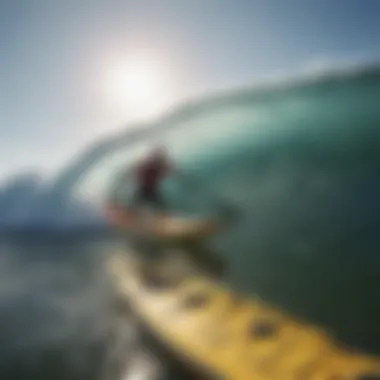
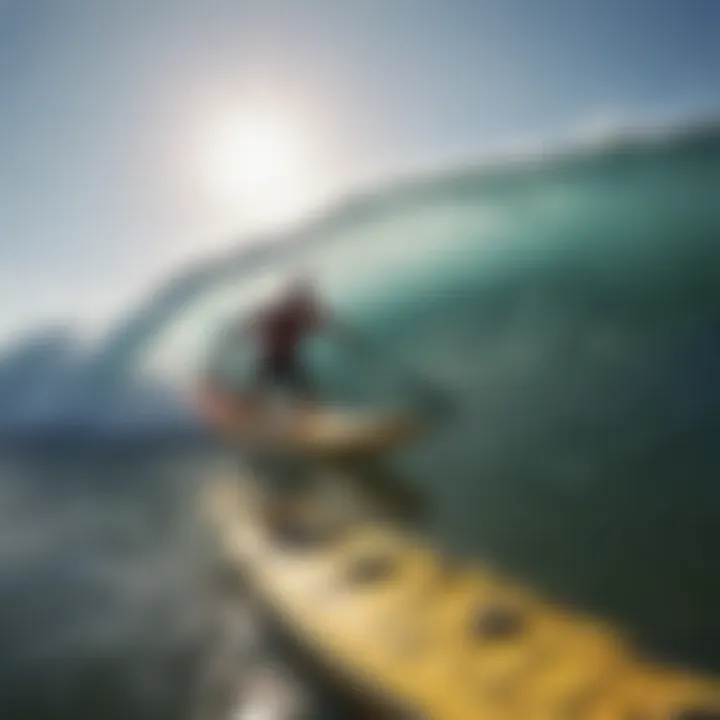
Storing folding paddle boards and kayaks incorrectly can lead to various issues. Since these crafts are designed to be lightweight and portable, mishandling their storage can result in compromised integrity. For example, folding a board without sufficient care might cause creases or permanent bends. Similarly, stacking kayaks on top of each other without padding can lead to scratches, dings, or even warping over time.
Here are some best practices to help avoid storage-related issues:
- Choose a Dry Location: Damp environments promote mold and mildew, which can ruin the materials. Ensure your storage area is dry and well-ventilated.
- Avoid Direct Sunlight: Prolonged exposure to sunlight can degrade certain materials, particularly if they are made of PVC or other plastics. Opt for a shaded area or store them indoors.
- Use Protective Covers: Covers not only guard against dust and environmental factors but also prevent scratches and cracks.
Proper storage is like a good foundation for a house; without it, things can come crashing down.
Environmental Considerations
When it comes to engaging with folding paddle boards and kayaks, environmental considerations cannot be overlooked. As both casual users and seasoned surfers embrace the water, they hold a shared responsibility towards protecting our natural resources. The eco-impact of our equipment choices plays a pivotal role in ensuring that this beloved pastime remains sustainable for generations to come.
Eco-friendly Materials
An important factor in selecting folding paddle boards and kayaks, which aims to minimize their environmental footprint, is the materials used in their construction. More brands are shifting to eco-friendly options that fulfill both durability and sustainability.
For instance, boards crafted with recyclable plastics or even bio-resins are becoming prevalent. These materials not only reduce reliance on virgin resources but also keep harmful substances out of our waterways. Some manufacturers are now also opting for bamboo, a fast-growing plant, known for its strength and natural resilience, making it a fitting alternative that doesn’t compromise performance or the planet.
By choosing products made from these sustainable resources, paddlers are making a conscious effort to support a greener future.
Sustainability Practices in Kayaking
Sustainability goes beyond just the materials. It encompasses practices that kayakers can implement both on and off the water. For instance, those who choose to paddle in designated areas, rather than sensitive habitats, contribute significantly to environmental preservation. Adopting the ethos of "leave no trace" is another core principle. Ensuring that locations are cleaned up post-usage not only shows respect for nature but sets a positive example for fellow enthusiasts.
Moreover, participating in community-driven clean-ups or conservation efforts fosters a spirit of collaboration among kayakers and paddle boarders. Grassroots organizations focused on environmental education pave the way for more responsible waterways. They inspire a collective movement to protect aquatic ecosystems and save threatened species that call them home.
In essence, the combination of selecting eco-friendly materials and advocating for sustainable practices fosters a holistic approach to watercraft usage. By embedding these principles into their routines, surfers, adventurers, and eco-enthusiasts can enjoy the world of paddling while ensuring its longevity.
User Experiences: Folding Paddle Boards and Kayaks
Gaining insights from users is crucial to understanding the real-world implications of folding paddle boards and kayaks. While specifications and marketing buzz tell one side of the story, the experiences of surfers and adventurers offer much-needed grounding. They provide a lens through which we can view the practical aspects of these watercraft, discern their strengths and weaknesses, and ultimately make informed choices. User experiences can help potential buyers to align their expectations with the reality of using folding equipment, especially regarding performance, convenience, and durability.
Insights from Casual Users
Casual users of folding paddle boards often express a sense of liberation when it comes to portability. The ease of transport can be a game changer. Many users, like Anna from San Diego, noted how much more they paddle since they no longer need a car roof rack or extra space for bulky equipment. She mentions, "I just fold it up and toss it in the back of my hatchback!"
A common sentiment among these individuals is the balance between enjoyment and practicality. For instance, casual paddlers appreciate how simple it is to set up and pack away after a day on the water. It's not just about getting the perfect wave; it's also about convenience. Users often remark on how they can easily join impromptu outings with friends or family, taking their board along without a hitch. However, some have pointed out that while folding boards are great for ease of transport, they may not always offer the same stiffness and stability as their traditional counterparts.
"I love how I can carry my board into the cafe after paddling, but it doesn’t feel as rigid as my friend's hardboard." – Mark, a recreational paddler.
Feedback from Experienced Surfers
Veteran surfers tend to approach folding paddle boards and kayaks with a more critical eye. Their insights generally focus on performance aspects, especially when in heavy surf or challenging conditions. For instance, seasoned surfer Lisa emphasizes that while the convenience of folding watercraft is undeniable, the real test comes with how they handle waves. Many experienced surfers express the need for a solid grip and reliable maneuverability to tackle more demanding surf conditions.
Interestingly, some have reported mixed feelings about the stability of folding boards. "I find them responsive and fun when the water is calm," mentions Dave, who has been surfing for over a decade. "But when the swells pick up, I often revert to my hard board. It's just more predictable in those scenarios."
Despite concerns, several experienced surfers still recommend folding boards for casual or mixed-water situations. They point out that modern designs and materials are closing the performance gap more effectively than ever before. Timing also matters; if there’s a sudden trip planned, the compact design makes all the difference.
In summary, user experiences highlight the dual nature of folding paddle boards and kayaks. Casual users enjoy the ease and flexibility, while experienced surfers often focus on performance and stability. The feedback from both groups provides valuable insights for anyone considering the adoption of these innovative watercraft.
Future Trends in Folding Watercraft
The world of folding watercraft is evolving, bringing fresh ideas to the surface. As advances in technology bloom, drifting into the waters of innovation feels more exciting than ever. Surfers and casual paddlers alike will be keen to see how these trends shape their experiences on the water. One must consider not just what’s possible now, but what may ripple through the industry in the near future.
Technological Innovations
In recent years, technology has fundamentally reshaped our approach to watercraft. Today, digital integration in folding paddle boards and kayaks is becoming the new norm. Imagine a setup where you sync a paddle board with a mobile app that tracks performance metrics. This kind of technological advancement does more than just amaze; it helps users improve their skills and understanding of water conditions. Customization options are growing too. Some manufacturers now offer boards designed specifically for add-ons, from fishing rod holders to GPS systems.
Also, advancements in materials cannot be overlooked. The use of lightweight composites enhances durability while maintaining portability—key for any folding design. For instance, developments in reinforced polymers and carbon fiber composites are paving the way for creating robust boards that withstand the test of time and rough waters.
"As technology spirals upward, the future unfolds with possibilities of watercraft that were once confined to imagination."
This also extends to the actual mechanism of folding. Innovative designs facilitate swifter setups and teardrop configurations that conserve space, making them more appealing to urban surfers. In essence, consumers are on the brink of enjoying watercraft that are not just functional, but also smart and user-friendly.
Market Outlook
Shifting gears to the market perspective, an upward trend in folding paddle boards and kayaks is evident. The growing interest in outdoor and adventure sports drives this market, bolstered by a wave of environmentally conscious consumers. More people are taking to the water, seeking sustainable options for their adventures, and folding models perfectly fit this bill due to their compact size and ease of transport.
Another factor molding the market outlook is accessibility. Folding paddle boards cater to those who may have previously been deterred by storage and transport concerns. As cities become more congested, the demand for compact and space-efficient solutions rises.
Moreover, collaboration between manufacturers and eco-friendly initiatives is gaining traction. Sustainable practices, from sourcing materials to production methods, are pivotal in attracting consumers today who are keen on minimizing their environmental footprint. Research suggests that there will be a steady growth in the niche of eco-friendly folding watercraft options, allowing for a wider selection that is both appealing and practical.
As we navigate through these dynamic trends in folding watercraft, it is clear that innovation is steering the adventurers’ course. With technological marvels and a favorable market pulling together, the horizon looks bright for those willing to embrace this new wave of watercraft.
Culmination
In wrapping up our exploration of folding paddle boards and kayaks, it’s essential to emphasize the foundational ideas that hold significance for surfers and water enthusiasts alike. The considerations discussed throughout this article play a crucial role in helping individuals make informed choices about which craft to adopt for their adventures. Here, we summarize key elements to keep in mind when considering folding paddle boards and kayaks:
- Portability and Design
Folding paddle boards shine in terms of convenience, making them easy to transport and store. Surfers often face logistical challenges, and the ability to pack a board in a car trunk or carry it on public transportation is a major selling point. Kayaks, while traditionally bulkier, have embraced similar advancements in design to offer better portability options. - Performance
The consideration of performance cannot be overstated. Folding paddle boards may not match the rigidity of their non-folding counterparts in surf conditions; however, advancements in materials and engineering have closed the performance gap significantly. Kayaks, meanwhile, continue to evolve with materials that enhance their stability and maneuverability in diverse conditions, suggesting a compelling choice for varied water experiences. - User Experience
Insights from casual users and seasoned surfers alike showcase the practicality and reliability of modern aquatic crafts. Failing to consider genuine user feedback can result in suboptimal purchases.
By recognizing these aspects, surfers can navigate the decision-making process more effectively, aligning their needs, preferences, and circumstances with the right equipment. Understanding nuanced distinctions shapes a more enjoyable, efficient, and ultimately fulfilling surfing experience.
Summary of Key Insights
As we delve deeper into this dialogue surrounding folding paddle boards and kayaks, several insights have emerged:
- Folding paddle boards excel in portability, making them ideal for urban dwellers or weekend warriors with limited storage.
- Although some might worry about the durability of these innovative designs, many modern boards have proven their mettle against more traditional builds.
- Kayaks retain their classic status among enthusiasts for their stability and adaptability across a range of conditions.
- The feedback from those who have firsthand experience helps illuminate what works well in real-world scenarios, offering a treasure trove of information for potential buyers.
Final Thoughts on Choosing the Right Craft
The decision of which craft to choose ultimately hinges on personal priorities and overall goals. Here are critical thoughts to ponder:
- Activity Focus
What type of water activities do you envision? If it’s just casual paddling on calm lakes, a folding paddle board might serve well. On the other hand, if planning for adventures that involve rapids or performance in waves, a kayak could be your best bet. - Budget Constraints
Evaluate the costs associated with each craft. Folding models can be pricey, but the investment often pays off in convenience and prolonged usage. - Environmental Impact
Consider the materials and brands that emphasize eco-friendly practices, aligning your equipment choices with personal values. Look for those that use sustainable materials or support environmental conservation.
Navigating these considerations thoughtfully leads to greater satisfaction and enhances the enjoyment of your time on the water. The world of paddle crafts is vast, but with the right awareness, you can find the ideal match for your aquatic pursuits.















